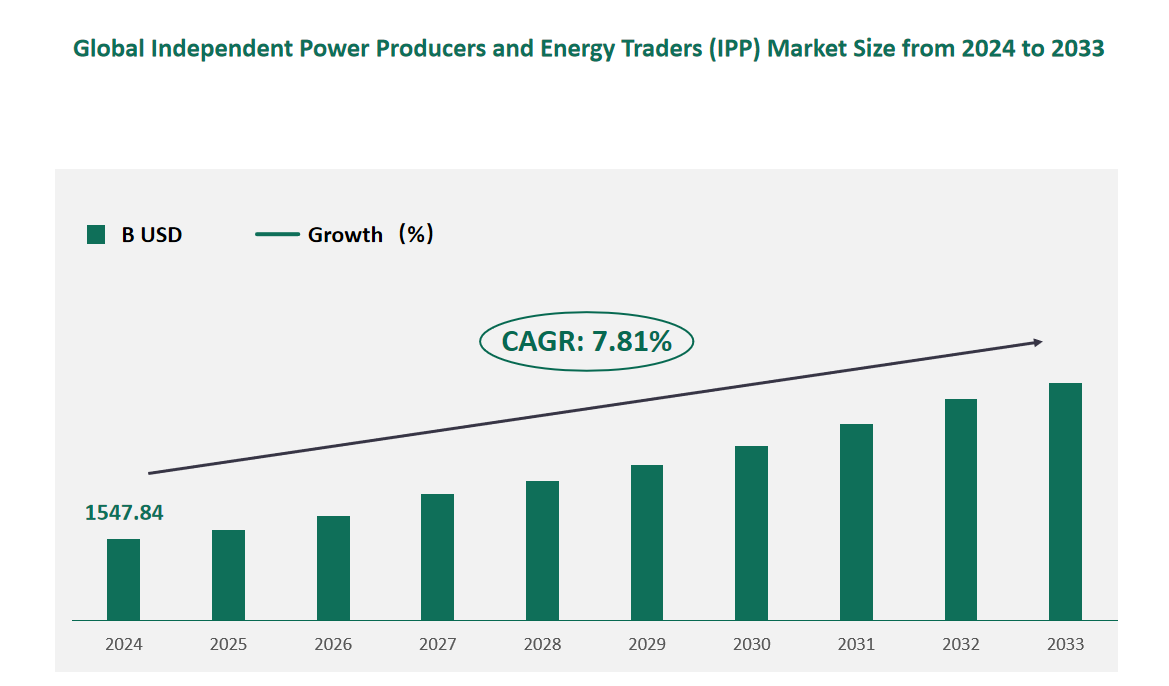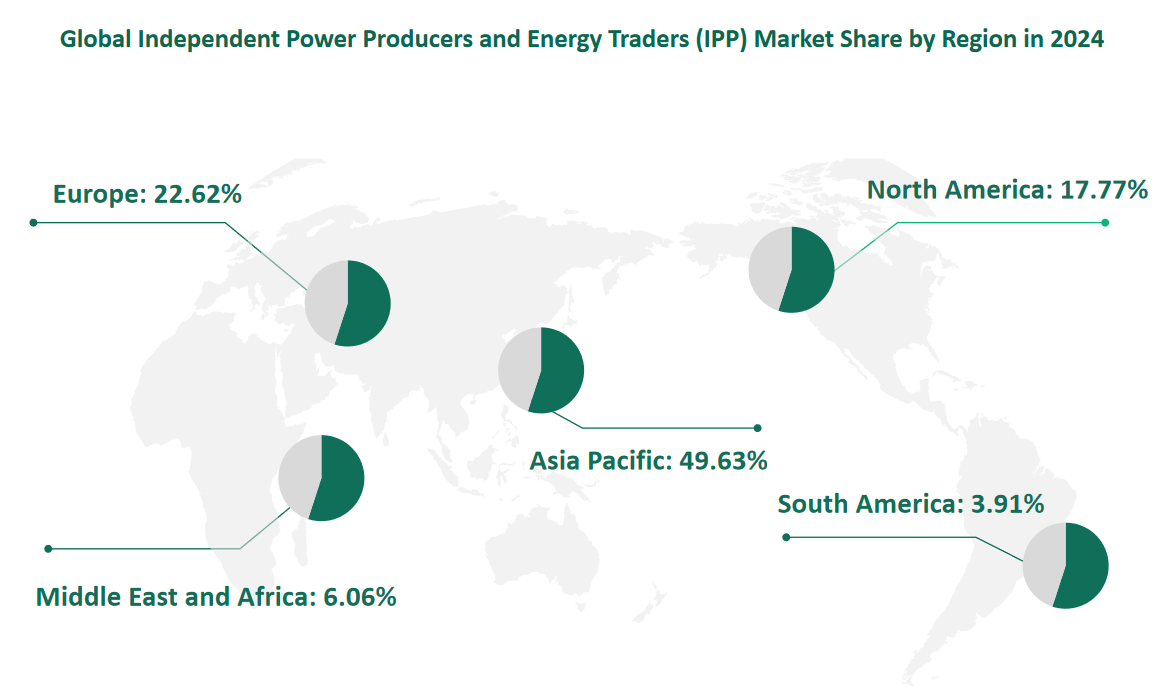1 Global Independent Power Producers and Energy Traders (IPP) Market Size (Value) and CAGR (2024-2033)
In 2024, the global Independent Power Producers and Energy Traders (IPP) market was valued at USD 1,547.84 billion, with a CAGR of 7.81% from 2024 to 2033.
Independent power producers and energy traders (IPP) refer to power generation enterprises that are engaged in power production but have no asset ties with power grid operators, and their owned generating units meet the conditions of grid-connected operation and participate in power market transactions on the generation side. That is, selling the produced electric energy to enterprises, governments, and end users.
Figure Global Independent Power Producers and Energy Traders (IPP) Market Size (M USD) and CAGR 2024-2033

2 Independent Power Producers and Energy Traders (IPP) Market Drivers
Rising Downstream Market Demand
The continuous increase in global electricity consumption is a primary driver for the IPP market. As economies develop and populations grow, the demand for electricity in various sectors—industrial, commercial, and residential—has surged. This demand is further exacerbated by the increasing reliance on electricity for heating, transportation, and other essential services. The tight supply of traditional energy sources, such as coal and natural gas, has led to a greater need for alternative and sustainable energy solutions. IPPs, with their flexibility and ability to quickly adapt to market needs, are well-positioned to meet this growing demand.
Development of New Energy Sources
The global shift towards renewable energy sources presents a significant opportunity for IPPs. Countries around the world are investing heavily in wind, solar, and hydroelectric power, recognizing these as low-cost and sustainable alternatives to traditional fossil fuels. Renewable energy sources are not only environmentally friendly but also offer long-term cost savings and energy security. IPPs are at the forefront of developing and operating these renewable energy projects, leveraging their expertise in power generation and trading to bring these new energy sources to the market. The increasing adoption of renewable energy is expected to drive the IPP market forward, as more countries set ambitious targets for clean energy integration.
Supportive Government Policies
Government policies play a crucial role in shaping the IPP market. Many countries offer incentives and support measures to encourage private investment in power generation projects. These policies include feed-in tariffs, tax credits, and regulatory frameworks that facilitate the development and operation of IPP projects. Governments also provide guarantees for power purchase agreements and fuel supply agreements, reducing the financial risks associated with IPP projects.
3 Independent Power Producers and Energy Traders (IPP) Market Restraints
Intense Market Competition
The electricity industry is characterized by intense competition, particularly in the generation and trading segments. IPPs face competition from both traditional utility companies and other IPPs, making it difficult to capture market share and achieve profitability. The market is often dominated by a few large players who have significant resources and established customer bases. New entrants and smaller IPPs may struggle to compete, especially in regions with well-established energy markets.
Large Upfront Investments
IPP projects typically require substantial upfront investments, especially during the development and construction phases. These investments include costs related to land acquisition, infrastructure development, and technology procurement. Securing financing for these projects can be challenging, particularly for smaller IPPs or those operating in less developed markets. The need for long-term financial commitments and the associated risks can deter potential investors, limiting the growth opportunities for IPPs.
4 Global Independent Power Producers and Energy Traders (IPP) Market Size and Share by Type in 2024
Nationalized IPPs are those that are owned, operated, or controlled by the state. These entities are typically characterized by their large-scale operations and significant influence on national energy policies. In 2024, the market size for Nationalized IPPs is estimated to be 884.54 billion USD. This segment includes major players such as Uniper SE, Huaneng Power International, and GD Power Development, which have substantial market shares and operate across multiple regions.
Nationalized IPPs play a crucial role in maintaining national energy security and ensuring a stable supply of electricity. They often invest in large-scale infrastructure projects, including hydroelectric power plants, nuclear power stations, and renewable energy projects. These entities are also responsible for implementing government policies related to energy production and distribution, making them integral to the overall energy strategy of a country.
Privately Owned IPPs are independent entities that are not affiliated with the state. These companies are driven by profit and often focus on innovative and flexible business models. In 2024, the market size for Privately Owned IPPs is projected to be 663.30 billion USD. Key players in this segment include AES Corporation, CGN Power, and Zhejiang Zheneng Electric Power, among others.
Privately Owned IPPs are known for their agility and ability to quickly adapt to market changes. They often invest in a diverse range of energy sources, including renewable energy projects, to capitalize on emerging market trends. These companies also play a significant role in promoting competition in the energy market, driving innovation, and improving operational efficiency. Their flexibility allows them to explore new markets and technologies, contributing to the overall growth of the IPP market.
Table Global Independent Power Producers and Energy Traders (IPP) Market Size and Share by Type in 2024
Type | Market Size (B USD) 2024 | Market Share 2024 |
Nationalized | 884.54 | 57.15% |
Privately Owned | 663.30 | 42.85% |
5 Global Independent Power Producers and Energy Traders (IPP) Market Size and Share by Application in 2024
Utilities refer to the systems or institutions responsible for maintaining public infrastructure services, including electricity, water supply, waste treatment, sewage treatment, gas supply, transportation, and communication. In 2024, the market size for Utilities is estimated to be 437.78 billion USD. This segment includes large-scale power generation and distribution companies that supply electricity to various sectors of the economy. Utilities are typically operated by government agencies, public enterprises, or government-licensed companies. They play a crucial role in ensuring a stable and reliable supply of electricity to support social production, business operations, and residential life.
End Users encompass a wide range of consumers, including residential households, commercial businesses, and industrial enterprises. In 2024, the market size for End Users is projected to be 1,110.06 billion USD. This segment includes private power plants and independent power producers that generate electricity for sale to specific customers or through power purchase agreements (PPAs). End Users are often involved in distributed energy systems, such as combined heat and power (CHP) plants, which can provide both electricity and heat to local consumers. The growth of renewable energy sources, such as solar and wind power, has also led to an increase in the number of small-scale power generation units that cater to the needs of specific end users.
Table Global Independent Power Producers and Energy Traders (IPP) Market Size and Share by Application in 2024
Application | Market Size (B USD) 2024 | Market Share 2024 |
Utilities | 437.78 | 28.28% |
End Users | 1110.06 | 71.72% |
6 Global Independent Power Producers and Energy Traders (IPP) Market Size by Region in 2024
North America, comprising the United States and Canada, is a significant market for IPPs. In 2024, the market size for North America is estimated to be 275.10 billion USD. The region is characterized by a mature energy market with a strong focus on renewable energy sources, particularly in the United States. Key players in this region include Uniper SE and AES Corporation, which operate across multiple states and provinces.
Europe is another major market for IPPs, with a projected market size of 350.07 billion USD in 2024. The region is known for its advanced energy infrastructure and strong commitment to renewable energy. Countries such as Germany, France, and the United Kingdom are at the forefront of adopting wind, solar, and hydroelectric power. The European market is also characterized by cross-border electricity trade, with interconnected power grids facilitating the exchange of energy between countries.
The Asia-Pacific region is the largest market for IPPs, with a projected market size of 768.25 billion USD in 2024. This region includes major economies such as China, Japan, and India, which have significant energy demands. The growth of the IPP market in Asia-Pacific is driven by rapid economic development, increasing urbanization, and the need for sustainable energy solutions. China, in particular, has been a major investor in renewable energy projects, with companies like China Yangtze Power and Guangdong Electric Power Development playing a significant role.
Figure Global Independent Power Producers and Energy Traders (IPP) Market Size by Region in 2024

7 Major Players in Global Independent Power Producers and Energy Traders (IPP) Market
7.1 Uniper SE
Company Profile
Uniper SE is a leading energy company based in Germany, with operations spanning Europe, North America, and Asia. Established in 2016, Uniper is known for its expertise in natural gas and electricity supply. The company is committed to decarbonization and offers a wide range of green products and services to industrial enterprises and public utilities.
Business Overview
Uniper SE’s main business includes the generation and trading of electricity and natural gas. The company operates a significant number of hydropower plants in Germany and Sweden, contributing to its low-carbon energy portfolio. Uniper also engages in the trading of various energy commodities, including liquefied natural gas and helium, across multiple continents.
Products, Services, and Solutions
Uniper SE provides a comprehensive suite of products and services aimed at decarbonizing energy supply and operations. This includes certified 100% renewable energy options, energy trading services, and solutions for industrial decarbonization. The company operates 109 hydropower plants in Germany and 76 in Sweden, contributing to its robust renewable energy portfolio.
Recent Financial Performance
In the most recent year, Uniper SE reported a revenue of 56.56 billion USD.
7.2 Huaneng Power International
Company Profile
Huaneng Power International is one of the largest power generation companies in China, with operations extending to Singapore and Pakistan. Established in 1994, the company is known for its large-scale power plants and commitment to sustainable energy development.
Business Overview
Huaneng Power International’s main business involves the development, construction, and management of large-scale power plants. The company operates in 26 provinces, autonomous regions, and municipalities in China, with a focus on thermal power, wind power, and solar power. Huaneng also has investments in power plants in Singapore and Pakistan, showcasing its international presence.
Products, Services, and Solutions
Huaneng Power International offers a diverse range of products and services, including electricity generation from thermal, wind, and solar sources. The company is also involved in the development of new energy projects, such as ultra-low emission standards for thermal power units. Huaneng’s commitment to innovation and sustainability is evident in its strategic cooperation with various regional governments and energy groups.
Recent Financial Performance
In the most recent year, Huaneng Power International reported a revenue of 34.78 billion USD.
7.3 GD Power Development
Company Profile
GD Power Development, established in 1992, is a core electric power listed company controlled by China National Energy Group. The company operates as a comprehensive platform for conventional energy power generation and is known for its diversified business portfolio.
Business Overview
GD Power Development’s main business includes electricity and heat production, power transmission, substation equipment maintenance, and environmental protection. The company operates in 28 provinces, municipalities, and autonomous regions in China, with a focus on thermal power, hydropower, wind power, and photovoltaic power generation.
Products, Services, and Solutions
GD Power Development offers a wide range of products and services related to power generation and environmental protection. The company invests in various industries, including coal, natural gas, and renewable energy sources. GD Power Development is also involved in the development of new energy projects, showcasing its commitment to sustainable energy solutions.
Recent Financial Performance
In the most recent year, GD Power Development reported a revenue of 28.75 billion USD.

